Easter – Trial and Crucifixion
Art Workshop
Summary of Lesson Activities:
Read Benjamin’s Box by Melody Carlson and decorate treasure boxes (cross boxes).
Scripture References:
Luke 22:47-23:56
Leader Preparation:
- Review background information and lesson materials.
- Gather necessary supplies.
- Write the memory verse on the board.
- Make a copy of the list of “treasures” for children to take home with their box.
Materials List:
- Bibles - For grades 1 & 2: Little Kids’ Adventure Bible, for grades 3 and up: Adventure Bible for Young Readers
- * The book: Journey to the Cross
- Treasure boxes (cardboard or papier mache cross boxes available from Oriental Trading catalog www.orientaltrading.com)
- Decorating supplies- jewels, paint, glitter
- Paintbrushes
- Glue
- Treasures from the story separated into a bag for each child
- Straw wrapped in small bunches for the box
- Horse or donkey fur
- Coins
- Pieces of a broken terra cotta pot or a ceramic cup
- Small twigs
- Small strips of leather
- Thorns or pieces of a thorny plant
- Nails
- Dice
- Cheesecloth cut into small pieces
- Small rocks
Time guidelines:
Welcome and introductions 5 minutes
Bible Study 10 minutes
Reading “Benjamin’s Box” 15 minutes
Decorating the boxes 20 minutes
Journals/Closing 10 minutes
Lesson Plan
Opening:
Welcome the children and introduce yourself. Make sure each child is wearing a nametag. Give the children a simple one or two sentence synopsis of what you will be doing during the workshop. Tell them they will be talking about the trial and crucifixion of Jesus and will create a “treasure box” that will help remind them of the greatest treasure in their lives.
Opening Prayer: Dear Lord, Thank you for the world around us. Thank you for the new life that we see in the spring. As we read about the sacrifices you made for each of us, help us to recognize all of the blessings in our lives. Amen.
Dig:
Bible Study:
Adventure Bible for Young Readers: Luke 22:47-23:56, Little Kids’ Adventure Bible: pages 348-355. See paraphrased version below.
Each workshop begins with the Bible story. One of our primary goals is to improve the children’s Bible literacy! If children did not bring their Bibles from home, use the classroom Bibles. Shepherds should help the children locate the stories. Use the handout “Helping Children Learn to Use their Bibles” and the Background Information to help you introduce the story.
**Remember, that as the Rotation progresses, the children will become more familiar with the story. When this happens, allow the children to tell you what they know. The children should still locate the story in their Bibles every week. Use the bold headings in their Bibles to guide your discussion. Then you can fill in any missing information and add additional details using the Background Information. One of greatest advantages of this model is that children who come regularly learn the story in great depth.
In this particular workshop, we will be focusing on the highlights in Luke’s Gospel, and then reading Benjamin’s Box by Melody Carlson.
Have the children locate the beginning of the story in Luke 22:47-23:56 (page 348-355 in Little Kids’ Adventure Bible).
Briefly review the story by looking over the headings in the Bible (in bold red and blue print for grades 1-2, in bold print for grades 3-6).
You may want to use the information and outline below to help you paraphrase the main points of the story (plan to spend only about 10 minutes on this part of the lesson). Discuss the Bible notes as time allows. Add more details as the Rotation progresses.
Introduce the Story:
Ask: Where would we find a story about Jesus and his friends? (gospels in the New Testament). Today’s story is found in all four gospels. (Matthew, Mark, Luke and John). We are going to do our Bible study from the gospel of Luke.
I am going to tell you the story and you will find portions of it. We’ll also look at some of the Bible notes. First, let’s review a little bit and remember what has been happening to Jesus…
Jesus and his disciples left Jerusalem after raising Lazarus. Jesus knew that that had really angered the religious leaders. They were determined to find a way to kill him. But now it was time for the Passover, a very important Jewish festival. Jesus and his disciples came back to Jerusalem to worship at the Temple to celebrate the Passover. When Jesus rode into Jerusalem people waved palm branches and welcomed him. They shouted out Hosanna, and called him King! They were so excited. Then on Thursday night Jesus ate his last meal with his disciples. We call this the ______. (Last Supper). He knew this was his last night to be with them. After the meal, they went out to the Mount of Olives in the Garden of Gethsemane. Jesus needed to pray. He knew what was coming and he needed God’s strength and closeness. The disciples all fell asleep. Jesus had hoped they would stay awake and pray with him…
Suddenly, there were loud shouts and noises. A crowd of soldiers and people rushed up. Judas had betrayed Jesus for 30 pieces of silver. With a kiss, on Jesus’ cheek, Judas let the soldiers know who to arrest. The guards arrested Jesus and took him away to the house of the chief priest.
Let’s find the story in our Bibles now…
"Jesus is Taken to the Sanhedrin" (Grades 1-2: page 348, Grades 3-6: Luke 22:54)
The soldiers and crowd took Jesus away to the house of Caiaphas, the high priest and president of the Sanhedrin. Do you know what the Sanhedrin is?
Locate and read the "Did you Know" Bible note (Grades 1-2: page 348 and Grades 3-6: page 1159): What was the Sanhedrin?
The Sanhedrin was a very powerful Jewish court. They didn’t like Jesus and what he had been teaching. They had been looking for a way to get rid of Jesus since Lazarus was raised from the dead. They were more interested in following the rules that they made up, rather than really doing what God wanted. The Sanhedrin was very powerful, but the Romans were really in charge. As long as the Sanhedrin kept things peaceful and quiet, the Romans let them do their own thing. Caiaphas was the high priest and the president of the Sanhedrin. He was afraid that Jesus was getting people too riled up – all this talk about new Kings and all. Maybe the people would even riot. If that happened, the Romans would take over and take away the Sanhedrin’s power. Caiaphas thought it would be better for Jesus to die, since he was just one man. Then everything would get back to normal.
Grades 3-6 only: People in Bible Times: "Caiaphas" (page 1263),
Now the Sanhedrin was known throughout the world for their just laws. But this night, they broke many of their own laws! (Refer to the Background Information for the list of broken laws.)
Caiaphas asked Jesus a lot of questions. “If you are the Christ, tell us,” they said. Are you the Christ? Are you the Son of God?” Jesus said, “I am. And you will see the Son of Man sitting at the right hand of God.” This made Caiaphas and the Sanhedrin furious! “This is blasphemy! We have heard it from his own lips. This man is claiming to be God, himself. He must die!”
Locate and read the People in Bible Times note: "Jesus" (Grades 1-2: page 289, Grades 3-6: page 1176). Jesus called himself the Son of God and the Son of Man. This means that Jesus is both God and human.
The Sanhedrin was furious! They spit on Jesus and hit him. They found Jesus guilty and said that he must die. But, remember, the Sanhedrin was very powerful, but they didn’t have the power to put anyone to death.
"Peter Says He Does Not Know Jesus" (Grades 1-2: page 349, Grades 3-6: page 1230)
Meanwhile Peter, Jesus’ disciple, was outside in the courtyard. A woman saw Peter and recognized him as one of Jesus’ followers. But Peter was afraid. He said three times that he didn’t know Jesus. Just as he said it the last time, a rooster crowed. At that very moment, Jesus turned and looked right at Peter. Jesus had told Peter that he would deny him three times before the rooster crowed. Peter felt terrible and cried and cried.
Grades 3-6: "The Guards make Fun of Jesus" (page 1231)
The guards made fun of Jesus. They laughed at him and hit him. They put a blindfold on his eyes and said, “Prophesy and tell who hit you.”
"Jesus Goes Before Pilate" (and Herod) (Grades 1-2: page 350, Grades 3-6: page 1231)
Early the next morning, the priests took Jesus to Pilate, the Roman governor. The Sanhedrin could arrest people and punish them, but only the Roman governor could sentence someone to be killed. They wanted Jesus put to death.
Read the People in Bible Times Note: "Pontius Pilate" (Grades 1-2: page 351, Grades 3-6: page 1160)
Pilate asked Jesus lots of questions too. He thought Jesus was innocent. He wanted the Sanhedrin to deal with Jesus on its own. Pilate discovered that Jesus was from Galilee, a different province than here in Jerusalem. So he sent Jesus to see Herod, who was the leader of Galilee. Herod was in town because of the Passover. Herod was excited to see Jesus. He hoped he would do some miracles for him. Herod asked Jesus many questions, but Jesus didn’t answer him. So Herod and his soldiers laughed at Jesus and made fun of him. They put a purple robe on him and laughed at the “king.” Then Herod sent Jesus back to Pilate. Pilate didn’t believe Jesus should die. He wanted to just whip him and let him go. But the Sanhedrin wanted Jesus killed and, remember, they could not do that. They kept after Pilate. Pilate offered to let Jesus go free, since the Romans always let a Jewish prisoner go free during Passover. But the priests and crowd asked Pilate to release a criminal named Barabbas instead. They wanted Jesus to die. The crowd screamed, “Crucify him! Crucify him!” Finally Pilate gave in. He ordered Jesus whipped and crucified.
Read the Life in Bible Times note: "Flogging" (Grades 1-2: page 352, “Whipping” Grades 3-6: page 1188)
Read the Life in Bible Times note: "The Cross" (Grades 1-2: pages 352-353, Grades 3-6: pages 1188 and 1232).
Grades 3-6 can also read People in Bible Times: "Simon" (page 1232) Explain that Simon would have carried just the horizontal cross piece of Jesus’ cross, not the entire cross as we typically see in pictures. The older children will probably be interested in more of the details of crucifixions. Use the background information to discuss with them.
"Jesus is Nailed to a Cross" (Grades 1-2: page 352, Grades 3-6: page 1232)
They took Jesus away to the place called Golgotha. It means “the skull.” They nailed his wrists and feet to the cross and left him there to die. The soldiers stood guard and made fun of Jesus. They put a sign above his head that read, “This is the King of the Jews.” They cast lots to see who would get to keep Jesus’ robe. (this is kind of like playing a game with dice) Jesus prayed, “Father forgive them. They don’t know what they are doing.” Two criminals were crucified on both sides of Jesus. One of them asked Jesus to remember him in heaven. Jesus promised that the man would be in heaven with Jesus that very day.
* "Jesus Dies" (Grades 1-2: page 354, Grades 3-6: page 1232) (there is good background information in Journey to the Cross about this section - you might want to have it out for the children to see)
At noon the sky turned dark. It lasted until 3:00. At 3:00 Jesus cried out,”Father, into your hands I commit my very life.” Then he died. Immediately the earth shook and the curtain in the Temple tore from top to bottom. The Roman commander standing in front of Jesus heard Jesus and saw what happened. He said, “Surely this man did what was right!”
"Jesus is Buried" (Grades 1-2: page 354, Grades 3-6: page 1189)
Joseph of Arimathea, a secret disciple of Jesus, went to Pilate and asked for Jesus’ body. Joseph wrapped Jesus’ body in linen and put him in a new tomb.
Grades 3-6: People in Bible Times: "Joseph of Arimathea" (page 1189)
Read the Life in Bible Times note: "Burial" (Grades 1-2: page 355, Grades 3-6: page 1265). (This should be review for our children as we have discussed Jewish burial customs in great length during the Jairus’ Daughter rotation and the Raising of Lazarus rotation)
Read the Life in Bible Times note: "Jesus’ Tomb" (Grades 1-2: page 356, Grades 3-6: page 1162).
Jesus’ friends and disciples and family watched all of this. What do you think they were thinking when they saw that Jesus had really died? How do you think they were feeling? How would you have felt if you had watched Jesus die and seen him buried?
But we know that this is not the end of the story… because three days later, what happened? We know that Jesus rose from the dead and is alive today! And that is what we celebrate at Easter!
Memory verse: During each rotation, the children will memorize one scripture verse. Locate and review the memory verse at this time.
Read story: Benjamin’s Box
Give each child a cross box (place a small bunch of straw inside) and a bag of treasures.
As you read the story, have the children place each item in the box as Benjamin did.
When you read the last page, have the children bow their heads in prayer, “Dear God, thank you for letting me find all these special treasures. But most of all, I thank you for sending me the greatest treasure of all. Thank you for sending Jesus. And help me to be a good servant for Jesus. Help me to tell everyone I know about the good news! Amen.”
Activity: Decorating the Treasure Box
Have the children write their names on the bottoms of their boxes before beginning to decorate.
As children are decorating their boxes, discuss questions from the Background Information - "Meaning of the Cross - FAQs" and "Definitions and People to Know."
Reflection:
The last 10 minutes should be reserved for Journal Reflection time. This is an opportunity for processing and reflection about what the children have learned. Ask the shepherds to pass out the journals and pencils/pens and the journal question sticker for the day. Workshop leaders and shepherds should sit down with children in small groups to facilitate discussion and writing in Faith Journals. Memory verse stickers are also included for each lesson. Children may copy the memory verse and illustrate it as an alternative to journal questions.
Journal Questions:
Grades 1-2: Draw a picture of some of the treasures you placed in your box. Who will you show these treasures to this week?
Grades 3-6: In today’s story, Benjamin learned that Jesus is the real treasure! How will you share the treasure of Jesus with others during this Easter season?
Closing Prayer: Gather the children together in a circle. Review with them one word or concept that they learned during today’s session. (Believe, Love, Resurrection, Treasure are some suggestions) Encourage children to come back next week for another workshop, and to invite their friends, especially their friends who do not belong to a church. Remind them to bring their Bibles. Ask for prayer requests and pray together.
Ask one of the children to read the prayer from Benjamin’s Box as the closing prayer.
Sources:
- Carlson, Melody. Benjamin’s Box. Zonderkidz Publishing, 1997, 9780310715054.
- Haidle, Helen. Journey to the Cross. Zonderkidz, 2001. (9780310700234 - out of print)
A lesson written by Jaymie Derden from State Street UMC
Bristol, VA
2003. Permission granted for non-commercial, local church use, provided credit is give to the source.
A representative of Rotation.org reformatted this post to improve readability.





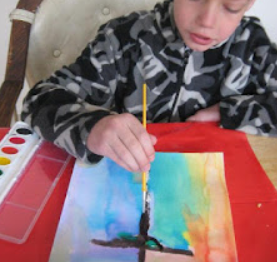
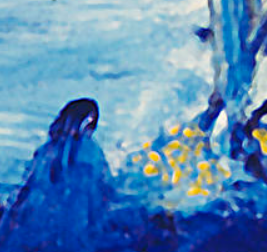



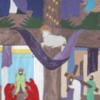


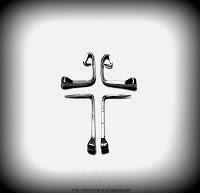


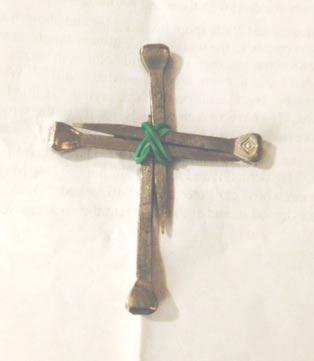





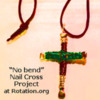
 This lesson plan blends the reading of the story of Christ's Crucifixion according to Mark with the creation of a Cross Necklace. I hope you like it.
This lesson plan blends the reading of the story of Christ's Crucifixion according to Mark with the creation of a Cross Necklace. I hope you like it.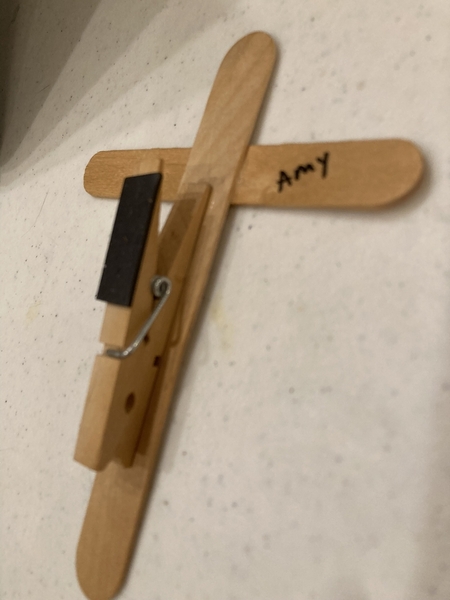








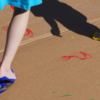
 To me, that sounds like the perfect MAGAZINE COLLAGE PROJECT.... items of "desire" torn from magazines, none of which are the things Jesus wants to give us, but they are all "Barrabbas" -- the things we want, instead of Jesus.
To me, that sounds like the perfect MAGAZINE COLLAGE PROJECT.... items of "desire" torn from magazines, none of which are the things Jesus wants to give us, but they are all "Barrabbas" -- the things we want, instead of Jesus.
